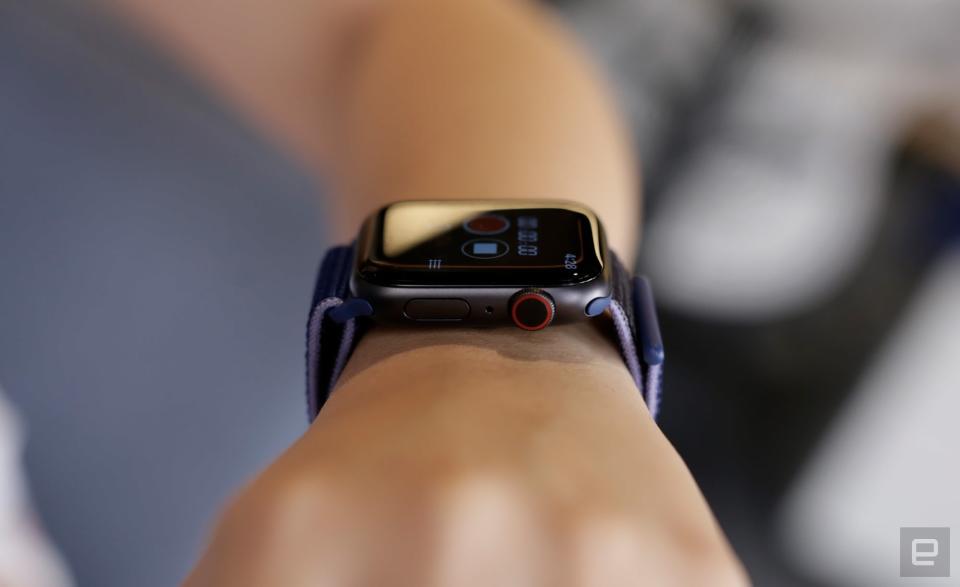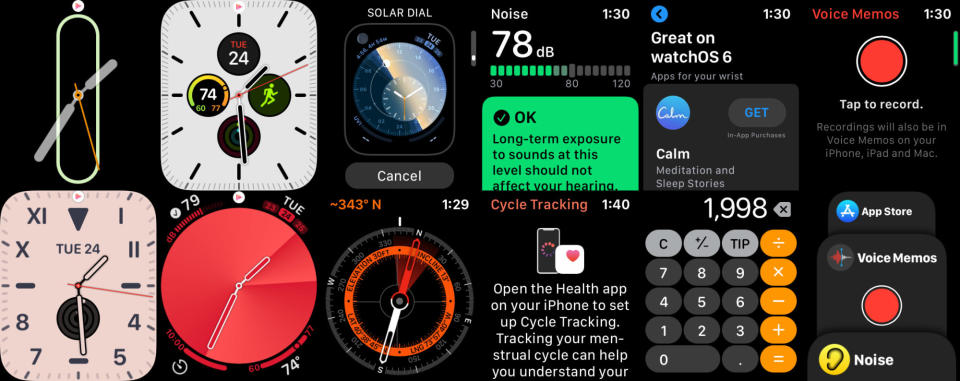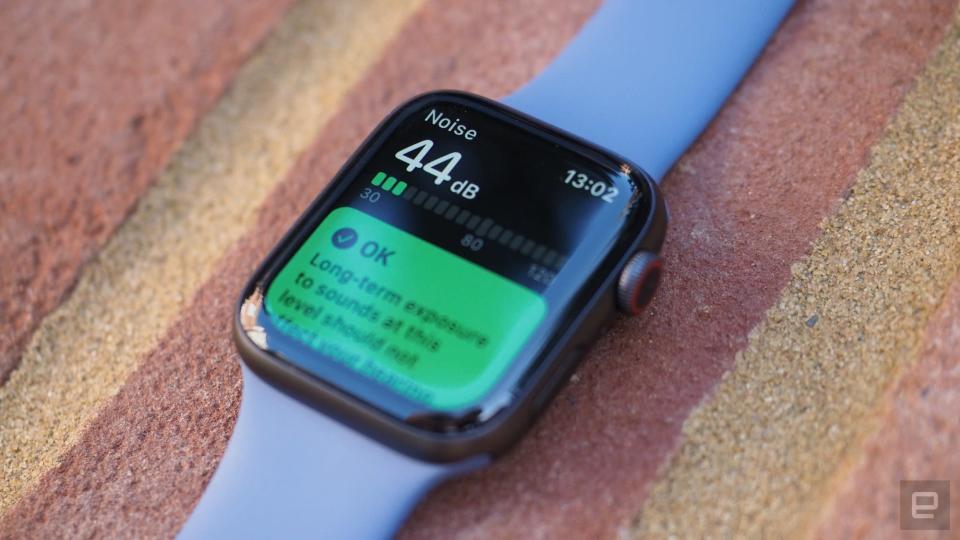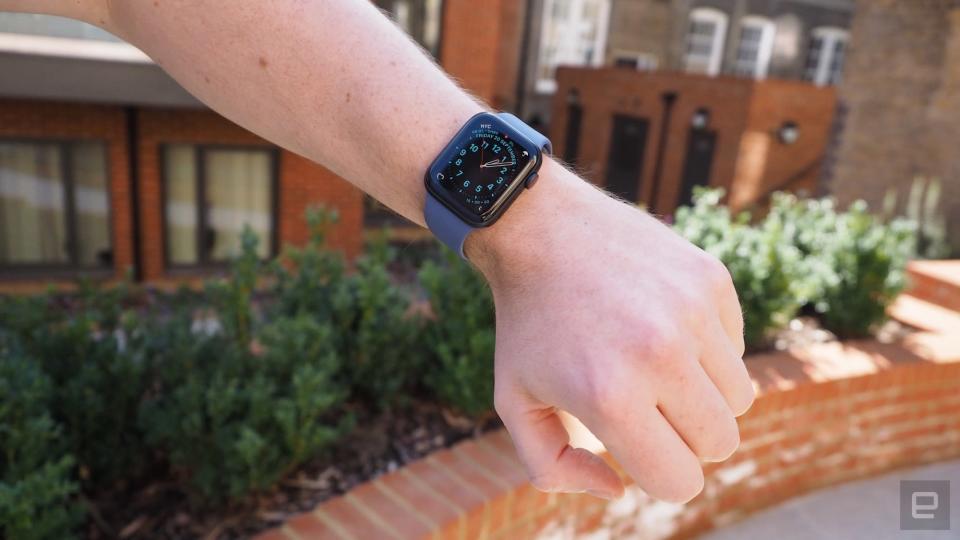Apple Watch Series 5 review: The best smartwatch gets (slightly) better
The Series 5 is similar to the Series 4, but shoppers buying their first Apple Watch won't mind.
Unboxing the Apple Watch Series 5 last week was an anticlimactic experience. The day the device arrived for review, I unfastened last year's Series 4, with its 40mm gold aluminum case and pale pink sports band. I put on the new watch, also with a 40mm gold case and pink silicone strap. The new Series 5 ($399 and up) looks identical to the model it replaces -- so much so that it wasn't until I turned the device on that I felt I had a new toy in hand. This is a minor product update, one that should leave recent Apple Watch buyers feeling secure in their decision to purchase when they did.
But this review isn't for people who already own a watch. Roughly 75 percent of people who buy an Apple Watch are doing so for the first time, according to Apple. For those of you who were already thinking about buying your first smartwatch, you can take some comfort knowing the Series 5 is just as good as the Series 4 you've been reading about, if not a little better.
There is one visible difference once you set up the device, and that's the always-on Retina display. Now, when your wrist is lowered, the screen will still show a modified version of whatever watchface you have, with the brightness dimmed to a low level. In fairness, you may have seen this sort of feature from other watch brands, like Samsung. For the uninitiated, the idea is that you can glance at the time, even when it's not convenient to raise your wrist. Say, when you're in a meeting, or in the middle of a bendy yoga pose, as one does. During my testing, I found myself glancing at the screen during a two-and-a-half hour movie I saw in theaters -- I was getting restless, but needed to be discreet if I was going to check the time.
To make this always-on screen possible, Apple adopted a new technology: a low-temperature poly-silicon and oxide display, or LTPO for short. What you need to know is that it gets down to refresh rates as low as 1Hz, which is critical, as otherwise the battery would drain before your workday is up. But it's not just components like an integrated circuit and ambient light sensor at work here. An Apple spokesperson tells me the company audited 34 watchfaces, making modifications on a case-by-case basis to help conserve battery life. In some cases, for example, an on-screen clock that counts the seconds now updates the time merely every minute in always-on mode. In the Workouts app, the timer that normally shows fractions of a second only shows whole seconds when the screen has been auto-dimmed.
In other instances, the dimmed watchface doesn't necessarily show less information, but it might be darker -- again, to conserve power. A white face might become black when your wrist is down. In the case of the Numerals watchface, boldly colored numbers darken so that you only see thin outlines of the numbers when the display is dim. You get the idea.
This is a good reminder, by the way, that the reason Apple can meticulously modify each watchface is that there are no third-party faces available for the Apple Watch. That can be a bummer if the three-dozen or so options aren't to your liking, or if you get bored.
Aside from power usage, Apple also had to consider people's privacy. When your wrist is down, a lot of things you wouldn't want bystanders to see are grayed out by default, even music controls. I was grateful to realize that my fellow subway riders couldn't see my current Spotify track or what podcast I was listening to. Because I'd really prefer to listen to Everything But the Girl in private and no, I don't have time to explain what "My Dad Wrote a Porno" is. If you want to go further than that to protect your privacy, there's a setting in the Apple Watch iOS app where you can flip a toggle to hide sensitive complications. That includes everything from calendar appointments to heart rate data.
Depending on your watchface of choice, this may or may not seem necessary. My default face are my fitness rings and frankly, I don't care who knows how many exercise minutes or stand hours I've gotten. And I actually prefer to see that info at a glance. It'd be great if Apple could add more granular options in a future software update -- say, a toggle for fitness stats, another for calendar appointments, and so on. For now, I recommend trying it both ways and seeing what suits you. You can do that in Apple Watch app, though oddly, not under privacy settings, but in the brightness settings.

I should say too that you can disable the always-on display altogether. Hey, maybe you'd rather your screen "blend in" -- well, to the extent that a computer screen strapped to your wrist can ever really blend in. But if you're concerned about battery life, let me say this. Apple rates the Series 5 at 18 hours of use -- the same as last year's model. I'll admit, it's hard for us to methodically test smartwatch batteries the way we do with smartphones and laptops, but for what it's worth, I can get a full workday, forget to charge my watch overnight, and still have juice left over the next day.
In one case, I made it about 21 hours before seeing the dreaded power reserve warning. (The watch shut off completely soon after.) My colleague Chris Velazco, who is also testing the watch, says he got nearly 24 hours off a charge on days when he wasn't exercising. As for workouts, Apple says the watch can last up to six hours on GPS models and up to five with LTE, the same rating as last year's Series 4. After a roughly three-and-a-half-hour run (auto-pauses not included), I had 72 percent juice left. Not too shabby. At any rate, you should try and remember to charge the device overnight, but keeping a spare charging cable in the office or your handbag is a solid plan B.

Continuing our tour of the device, you'll see the screen sizes are the same -- that's 40mm and 44mm. The Digital Crown is still there, of course. And there's that rectangular button on the side, which you probably won't be using too often. In the Series 4 cellular model, you could hold down this button to make emergency calls. Now, with the Series 5, you can do that while traveling internationally too. Again, provided it's an LTE model. Hopefully you never have to use this feature, but it's nice to know it's there.
As I said, my review unit is made of aluminum, which is one of the reasons it looks identical to the Series 4. In both cases, the entry-level models have an aluminum finish, and they're offered in the same colors: silver, space gray and gold. The stainless steel edition has carried over, too. If you want people to know you have the 2019 model, you're going to have to pay even more. There's a new titanium finish, which starts at $799 -- it's a lot lighter than stainless steel, and the finish is matte; not at all glossy. I'd recommend that to people like me, who want a watch for sports (running in my case), but also want to wear that device to work. Then again, the aluminum model is also lightweight and also matches workwear, if I do say so myself.
Lastly, Apple brought back a ceramic edition this year. It comes in a gorgeous all-white finish and it starts at an eye-watering $1,299. Woof! Something tells me most of you are going to just choose the aluminum model and call it a day. The Apple Watch will make a great gift this holiday season, but I'm not sure how many of you have been good enough this year to have earned a smartwatch that costs as much as a MacBook Pro.

The last hardware feature is also a software feature. A built in compass shows you what direction you're pointing in. There's even a standalone Compass app, that shows -- you guessed it -- a compass, along with the incline, elevation, latitude and longitude. I don't really need that here on the ninth floor of Engadget's office building, but I can definitely see it coming in handy if I were an avid hiker.
If you're a city slicker like me, you can still get use out of the compass, either inside Apple's own maps app, or certain third-party apps like Yelp. In Yelp, pick a destination, select walking directions and voila, you can see yourself on the map, with confirmation you're going in the right direction. It's nice to be able to keep your phone in your pocket, especially if you're in a strange city, and trying your hardest not to look like a tourist.

Other than that, it's just a bunch of new software tricks, all of which, by the way, you can get through the watchOS 6 update. That's available for just about every Apple Watch ever made, except for the very first one that came out in 2015. For starters, there's now an App Store on the watch itself, so you can browse and install from there, without getting your phone involved. I'll admit, this isn't a feature I found myself using often during my testing, especially knowing that Apple Watch apps are kinda hit or miss in terms of quality. But hey, it's nice to have. For what it's worth, installing Night Sky took me about a minute, not unlike downloading a podcast episode to my phone.
Beyond that, there's a bunch of new health and fitness features on board, including a hearing health feature that can tell if you've been exposed to dangerous decibel levels. An activity trends view in the iOS Activity app gives you a longer-term look at your fitness progress.

Lastly, there's menstrual cycle tracking for logging symptoms, predicting the start of your next period and predicting a woman's fertile period -- in case she's trying to get pregnant, or maybe if she's trying not to. Similar to other platforms' cycle tracking apps, like what Garmin offers, you can log physical and emotional symptoms, rate the heaviness of your flow and even log when you had sex and whether you used protection.
I imagine some women will avoid this out of caution altogether, no matter the platform or privacy assurances. Apple says your data is encrypted both on the device and in the cloud. For my part, having used cycle tracking now in both Apple and Garmin's respective health apps, I prefer Apple's design, even though the features are quite similar.
Siri has also learned a few more tricks: it can identify songs you're hearing, and show little webpage previews on your wrist when you're getting answers to questions. The song identification, powered by Shazam, works as well as Shazam used to as a standalone service -- which is to say it's spot on. The webpage thing works, but I didn't find it useful. Load speeds were slow and the pages weren't optimized for the Watch's tiny screen.

Other additions: standalone apps for audiobooks, voice memos and, perhaps best of all, a calculator with a little tip button inside. You know you love it.
Throughout, performance on the watch feels snappy, but not noticeably faster than the Series 4. There's a new chip inside -- S5 instead of S4 -- but again, the performance leap is immaterial compared to what it felt like upgrading from the Series 3 to the Series 4.
Then there's all the stuff the Series 4 could already do last year. Think: automatic workout detection, a built-in ECG test for potential heart arrhythmias and fall detection in case you take a spill. Those were selling points then, and they're selling points now. Speaking of the native workout app, I still prefer it to most third-party options. Its feature set should be enough for most people, but I am eager to see Apple add some additional functionality through a software update. How about time-based intervals for runners, eh, Apple?
And that seems like a fitting place to end this review: the Series 5 is the best smartwatch you can buy, but it also feels a lot like last year's best smartwatch, the Series 4. If you own last year's model, there's no need to upgrade. But if you're part of the majority of people who Apple says are buying an Apple Watch for the first time, this is a very good, very safe time to take the plunge.

